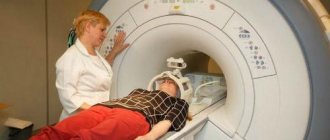- Symptoms of intracranial pressure in adults
- Headache
- Nausea and vomiting in the absence of gastrointestinal diseases
- Increased fatigue
- Irritability
- Changes in blood pressure, tachycardia, arrhythmia
- Decreased libido
- Meteosensitivity
- What to do if the above symptoms appear?
- Lumbar puncture
- Treatment of intracranial pressure in adults
- Treatment with medications
The condition of increased intracranial (intracranial) pressure is called liquor-hypertension syndrome, intracranial hypertension. This condition differs from the familiar arterial hypertension. The disease can occur for unknown reasons (idiopathic form), and it also appears with head injuries, tumors and inflammatory diseases of the brain.
Symptoms of intracranial pressure in adults
It is not always possible for a person to understand that he has increased intracranial pressure. This is caused by an abundance of symptoms that occur with other diseases.
Headache
Adults often suffer from headaches that arise for various reasons. Even healthy people can get headaches due to overwork during hard work, staying in a stuffy room, or an uncomfortable pillow for sleeping.
Headache due to impaired circulation of cerebrospinal fluid is of a peculiar nature. There is a feeling of fullness, as if something is pressing from within. Such sensations manifest themselves most strongly in the forehead and crown of the head, and there is a feeling of pressure on the eyes from the inside. Because of this, vision becomes blurred, especially when moving the eyeballs. The feeling of a veil before the eyes is due to the fact that the optic nerve swells.
If a headache attack is accompanied by nausea, this may also indicate problems with intracranial pressure. With severe pain, nausea leads to vomiting, but after emptying the stomach, the state of health does not improve. In some patients, the disease provokes fainting and confusion.
The nature of headaches changes with changes in body position and depends on the time of day. The headache is worst in the evening and at night. At such times, activity decreases, the person rests or prepares for sleep. In a lying or reclining position, the pain intensifies. This is caused by increased production of cerebrospinal fluid when its outflow worsens. For this reason, the compression intensifies.
Nausea and vomiting in the absence of gastrointestinal diseases
Almost everyone has experienced nausea and vomiting without gastrointestinal diseases at least once due to poor quality food eaten. If everything is in order with the diet and no pathologies of the digestive system are found during the examination, it is worth suspecting neurological causes of this condition. As a rule, nausea is accompanied by a headache and progresses to vomiting.
Increased fatigue
Any pathology in the body weakens it, so a person quickly gets tired and loses the ability to work productively. Fatigue is a symptom of all diseases without exception, so you should pay attention to other signs.
Irritability
Emotional lability often accompanies neurological diseases. Due to constant poor health and deteriorating quality of life, a person becomes less balanced. Some patients report tearfulness and increased anxiety. This can happen for various reasons, but if there is pain, blurred vision, then irritability can be another sign of intracranial hypertension.
Changes in blood pressure, tachycardia, arrhythmia
Blood pressure and intracranial pressure are different indicators, but they are related. Due to compression of individual brain structures and blood vessels, blood circulation is disrupted. This affects the functioning of the cardiovascular system. A person complains of pressure surges, uneven pulse, and sweating. This is associated with intracranial hypertension and is not an independent disease. The situation may be aggravated if the patient has diseases of the cardiovascular system.
Decreased libido
People with chronic intracranial hypertension almost always feel unwell. Fatigue, irritability and other symptoms of the disease do not contribute to a pronounced desire for physical intimacy. This applies to patients of any gender. At the same time, it cannot be argued that such a condition occurs only when the circulation of cerebrospinal fluid is disrupted. The reasons may be fatigue, psychological problems, endocrine changes.
Meteosensitivity
If increased meteosensitivity was not characteristic before, but appeared suddenly, the cause may be intracranial hypertension. When the weather changes, a person begins to have headaches, feel dizzy, and have trouble sleeping. In a number of patients, weather sensitivity manifests itself as fluctuations in blood pressure. The whole body or individual muscle groups and joints begin to ache.
3.Methods of controlling intracranial pressure
In order to measure ICP, a measuring device is placed in the cerebrospinal fluid either directly in the cerebral ventricles or at the level of the spinal cord. This procedure is done using several methods:
- epidural;
- subdural;
- using an intraventricular catheter.
The epidural method of controlling ICP involves implanting an epidural sensor (sensor) in the area between the inner surface of the skull and the dura mater of the brain. This procedure is performed under local anesthesia. First, an incision is made on the scalp, freed from hair, then a burr hole is made, into which an epidural pressure measurement sensor is inserted. This technique can be considered quite gentle, but it is used exclusively to obtain intracranial pressure readings - it is impossible to influence the level of ICP parameters with its help.
The subdural method, unlike the epidural one, is used much less frequently - it is mainly indicated in emergency situations. With the subdural method of ICP control, a pressure measurement sensor is implanted deeper through the burr hole - in the area between the dura and arachnoid membranes of the brain.
As for the third method of measuring intracranial pressure using an intraventricular catheter, it allows not only to control ICP, but also to normalize it due to the possibility of pumping out excess cerebrospinal fluid through the catheter.
About our clinic Chistye Prudy metro station Medintercom page!
What to do if the above symptoms appear?
If there are signs of the disease, you should consult a neurologist. To treat a pathological condition, it is necessary to find out its exact cause. That is why the doctor prescribes a set of diagnostic procedures:
- Fundus examination. Allows you to identify swelling of the optic nerve - one of the main signs of intracranial hypertension.
- Echoencephalography is an ultrasound procedure for examining brain tissue. Such diagnostics will help confirm or refute the presence of a tumor, cyst, hemorrhage, or other pathological changes in tissue structure. This diagnostic method does not require preparation, changes in daily routine or nutrition.
- X-ray of the skull. Prescribed for suspected birth defects, fractures or bone displacement. This method also identifies possible tumors that are causing compression.
- CT or MRI of the head. The most accurate and informative diagnostic methods. They allow you to thoroughly assess the condition of bones, soft tissues, and blood vessels. As a rule, the doctor prescribes such a diagnosis after echoencephalography, if it shows the presence of a pathological process.
- Ultrasound of the vessels supplying the brain. It is necessary to identify possible anomalies, tortuosities, and thromboses.
- Angiography. Allows you to visualize large and small vessels and detect areas of affected arteries.
The purpose of the above procedures is to determine the cause of the malaise. Based on the examination results, the specialist prescribes additional diagnostics or decides on treatment.
Treatment of increased intracranial pressure at ON CLINIC Ryazan
If ICP is a secondary disorder and represents one of the complications of any disease, it is necessary first of all to treat the primary pathology. In other cases, symptomatic treatment of ICP is performed.
There are conservative and surgical treatments for this pathology. Conservative - taking medications prescribed by the attending physician that enhance the outflow of fluid according to the regimen prescribed by the attending physician. These can be either regular diuretics or anti-inflammatory steroids. Physiotherapy and massage have also been proven to treat increased intracranial pressure.
Surgical intervention is performed in the most severe cases of ICP. Usually this is bypass surgery - the installation of a special shunt through which excess fluid moves away from the brain, rushing into the abdominal cavity.
Untreated ICP in a timely manner can lead to such serious complications as stroke, partial and complete paralysis, impaired coordination, reflexes, speech, as well as loss of vision and mental problems. If you experience symptoms that may be signs of a deterioration in the flow of cerebrospinal fluid from the brain, consult a doctor as soon as possible! “ON CLINIC Ryazan” - Your health is our concern!
Lumbar puncture
If hardware diagnostics do not help identify the cause of the disease, the neurologist prescribes a lumbar puncture - a lumbar puncture. It is an invasive procedure performed to obtain a sample of cerebrospinal fluid. The procedure can be performed for diagnostic and therapeutic purposes. During diagnosis, a lumbar puncture helps to more accurately determine the degree of pressure increase. For therapeutic purposes, the procedure is performed for benign intracranial hypertension to improve the patient’s condition.
Read also
Multiple sclerosis
Multiple sclerosis (MS) is a chronic disease, contrary to popular belief, completely unrelated to attention disorders and senile sclerosis.
In this case, the term “sclerosis” means... Read more
Epicondylitis
Do you know this disgusting feeling when you are passionately doing something, and suddenly, quite by accident, your elbow bumps into something hard and in that very place, after the impact of which the whole arm weakens...
More details
Myasthenia gravis
MYASTHENIAS – a disease associated with a disruption of the immune system, as a result of which antibodies are produced against the body’s own tissues involved in the transmission of nerve impulses, which...
More details
Intracranial hypertension
Intracranial hypertension is a condition (syndrome) associated with increased cerebrospinal fluid (CSF) pressure inside the skull. The main symptoms of increased intracranial pressure are...
More details
Weakness and numbness in the arm and leg
The appearance of general muscle weakness and numbness in the body, arm or leg is a very serious syndrome, and if it occurs, you should consult a neurologist as soon as possible. Connected…
More details
Treatment of intracranial pressure in adults
To improve the patient's well-being, it is necessary to achieve normalization of intracranial pressure. In modern practice, non-surgical and surgical treatment methods are used. Surgery is required if diagnosis reveals a tumor or cystic change. Some patients are diagnosed with a congenital abnormality of the brain structure. Such tumors must be removed. The operation will eliminate the compression and thereby normalize the pressure.
Depending on the severity of the patient’s condition, the procedure is performed immediately, or the patient is given a date for surgery. Urgent surgical treatment is carried out in severe condition of the patient, when the degree of the disease threatens brain dislocation. With dislocation syndrome, compression causes a displacement of brain structures relative to each other. There are eight types of brain dislocation, each of which has its own characteristic manifestations.
In one of them, the cerebellar tonsils penetrate the foramen nagnum - a large oval hole in the occipital part of the skull; due to increasing hypertension, the brain stem, on which vital nerve centers are located, is compressed. They are responsible for the functions of the heart and respiratory system. When these areas are damaged, the disease is most severe. The patient's breathing becomes impaired, the pharyngeal reflex disappears, and the pressure drops. These conditions are directly life-threatening and require immediate surgery.
Definition and physiological norms of ICP
Intracranial pressure is the pressure that is formed in the cranial cavity under the influence of several anatomical structures, namely: blood volume, intracerebral fluid and brain tissue.
Normally, intracranial pressure indicators fluctuate within the following limits:
- in adults (3-15 mm Hg);
- in children aged 1 to 15 years (3-7 mm Hg);
- in newborns and children under 1 year (1.5 – 6 mm Hg).
These values are typical for people at rest, since during physical activity accompanied by muscle tension, a short-term increase in values up to 50-60 mm occurs. rt. Art. The phenomenon is due to the activation of compensatory mechanisms for adequate functioning of the central nervous system. Manifestations of increased cerebral pressure are diagnosed when compensatory mechanisms are disrupted when they cannot cope with the increase in values.
Intracranial hypertension: diagnosis
Types of pathology diagnostics include:
- measuring intracranial pressure by inserting a needle into the fluid cavities of the skull or spinal canal with a pressure gauge attached to it.
- tracking the degree of blood filling and dilation of the veins of the eyeball. If the patient has red eyes, that is, the eye veins are abundantly filled with blood and are clearly visible, we can talk about increased intracranial pressure;
- ultrasound examination of cerebral vessels;
- magnetic resonance and computed tomography: the expansion of the fluid cavities of the brain is examined, as well as the degree of rarefaction of the edges of the ventricle;
- conducting an encephalogram.










